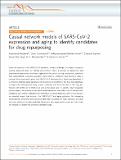| dc.contributor.author | Belyaeva, Anastasiya | |
| dc.contributor.author | Cammarata, Louis | |
| dc.contributor.author | Radhakrishnan, Adityanarayanan | |
| dc.contributor.author | Squires, Chandler | |
| dc.contributor.author | Yang, Karren Dai | |
| dc.contributor.author | Shivashankar, G. V. | |
| dc.contributor.author | Uhler, Caroline | |
| dc.date.accessioned | 2021-02-17T22:57:55Z | |
| dc.date.available | 2021-02-17T22:57:55Z | |
| dc.date.issued | 2021-02 | |
| dc.date.submitted | 2020-01 | |
| dc.identifier.issn | 2041-1723 | |
| dc.identifier.uri | https://hdl.handle.net/1721.1/129806 | |
| dc.description.abstract | Given the severity of the SARS-CoV-2 pandemic, a major challenge is to rapidly repurpose existing approved drugs for clinical interventions. While a number of data-driven and experimental approaches have been suggested in the context of drug repurposing, a platform that systematically integrates available transcriptomic, proteomic and structural data is missing. More importantly, given that SARS-CoV-2 pathogenicity is highly age-dependent, it is critical to integrate aging signatures into drug discovery platforms. We here take advantage of large-scale transcriptional drug screens combined with RNA-seq data of the lung epithelium with SARS-CoV-2 infection as well as the aging lung. To identify robust druggable protein targets, we propose a principled causal framework that makes use of multiple data modalities. Our analysis highlights the importance of serine/threonine and tyrosine kinases as potential targets that intersect the SARS-CoV-2 and aging pathways. By integrating transcriptomic, proteomic and structural data that is available for many diseases, our drug discovery platform is broadly applicable. Rigorous in vitro experiments as well as clinical trials are needed to validate the identified candidate drugs. | en_US |
| dc.description.sponsorship | National Science Foundation (DMS-1651995) | en_US |
| dc.description.sponsorship | ONR (N00014-17-1-2147 and N00014-18-1-2765) | en_US |
| dc.publisher | Springer Science and Business Media LLC | en_US |
| dc.relation.isversionof | https://doi.org/10.1038/s41467-021-21056-z | en_US |
| dc.rights | Creative Commons Attribution 4.0 International license | en_US |
| dc.rights.uri | https://creativecommons.org/licenses/by/4.0/ | en_US |
| dc.source | Nature | en_US |
| dc.title | Causal network models of SARS-CoV-2 expression and aging to identify candidates for drug repurposing | en_US |
| dc.type | Article | en_US |
| dc.identifier.citation | Belyaeva, Anastasiya et al. "Causal network models of SARS-CoV-2 expression and aging to identify candidates for drug repurposing." Nature Communications 12, 1 (February 2021): 1024 © 2021 The Author(s) | en_US |
| dc.contributor.department | Massachusetts Institute of Technology. Laboratory for Information and Decision Systems | |
| dc.contributor.department | Massachusetts Institute of Technology. Institute for Data, Systems, and Society | |
| dc.relation.journal | Nature Communications | en_US |
| dc.eprint.version | Final published version | en_US |
| dc.type.uri | http://purl.org/eprint/type/JournalArticle | en_US |
| eprint.status | http://purl.org/eprint/status/PeerReviewed | en_US |
| dspace.date.submission | 2021-02-17T12:51:09Z | |
| mit.journal.volume | 12 | en_US |
| mit.journal.issue | 1 | en_US |
| mit.license | PUBLISHER_CC | |
| mit.metadata.status | Complete | |
